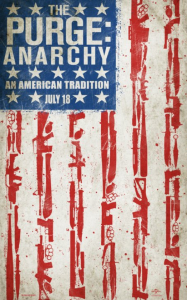
 Tough guy movies often look best in low resolution.
Tough guy movies often look best in low resolution.
Memphis attorney Rusty White had thousands of movies on VHS. The tapes were meticulously stored on shelves wherever he lived. And my film education really started with his collection. He selected all kinds of movies for me to watch. One such film was John Carpenter’s “Assault on Precinct 13.” As I remember, Rusty’s VHS copy was recorded from cable television, and it was smeary and the tracking often had to be adjusted, but I loved it. And even though I’ve seen the film in higher resolution since that time, I think it looks best bad.
“The Purge: Anarchy” is the kind of bad movie that ought to be projected ugly. It is nothing more than exploitative, trashy satire, but it does work and is a more complete film than its predecessor.
Taking place in the same parallel universe of the unexpected indie 2013 hit film that launched the franchise, this “Purge” adventure follows a similar story arch. It is the year 2023, the United States government has been reformed in a Fascist fashion. Crime is reduced to just one night–the night of the Purge. In order to battle crime, the government has made it law to commit it, but only once a year. And during that horrible night, people die.
This absurdist, science fiction tale follows in the footsteps of 1970s sci-fi entries like “Rollerball” and “Death Race 2000.” The masses need an outlet and if that outlet is violent enough, you can control the population, theoretically, by limiting the desire for revolution. And like “The Hunger Games,” it will all be broadcasted live. When a young couple’s car breaks down on their way to safety on the night of the Purge, they must try to survive on the outside. Lucky for them that not everyone is in favor of the new American tradition. But the help they receive is never what it seems.
Written and directed by James DeMonaco (who brought us the first one), “The Purge: Anarchy” is a dystopian clone that works best when it makes you uncomfortable. Given the current “guns everywhere” climate, watching the film will make you look around at the folks sitting next to you. Are your fellow viewers packing heat? The concept is based on revenge and an almost carnal, base lust for blood. There is a scene in the film where the characters pass through the financial district of the city–the bloody corpse of a banker hangs above one of the banking institutions. The broad satire being explored is handled bluntly, but the point is clear: be careful who you wrong.
Like Carpenter’s 1976 classic “Assault on Precinct 13,” this “Purge” outing repeats violent scenes where people are torn apart by gunfire. It does wear you down and the payoff is weak. But the ideas may resonate. What would you do if you could kill someone and get away with it? Or better yet, what if the law said it was okay, or even thought of as your duty as a citizen? In the mixed up world of the “Purge” these questions haunt the characters. The answers all come at the end of the barrel of a smoking gun. And happiness is a warmer weapon.
But while watching this film, I kept thinking about my friend and mentor Rusty White, a film critic, fantastic writer, and a criminal defense attorney who handled some of the ugliest murder cases in Memphis over the last decade. His work on some of the most violent and heinous criminal cases is well-known. But before you think Rusty was a hired gun who represented only the wicked, think about what his work meant to a civilized society. We don’t Purge in our universe because the law is there and everyone is protected by it, even if you are the criminal.
Rusty died unexpectedly on Sunday. I think he liked bad movies, because he could see the good in them somewhere. And he represented people who are labeled “bad,” because labels are often too rigid. Rusty might agree that sometimes the world looks best on old VHS.
